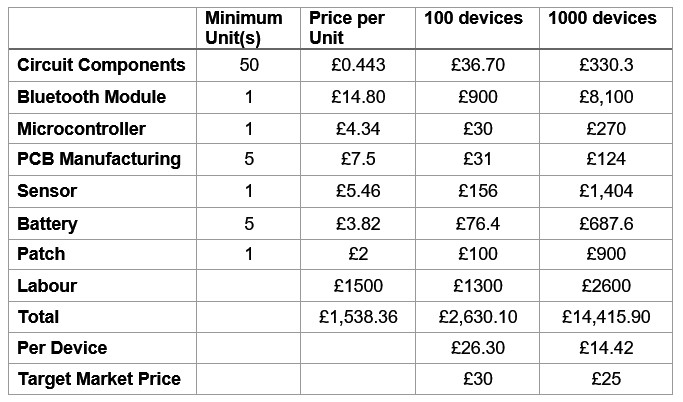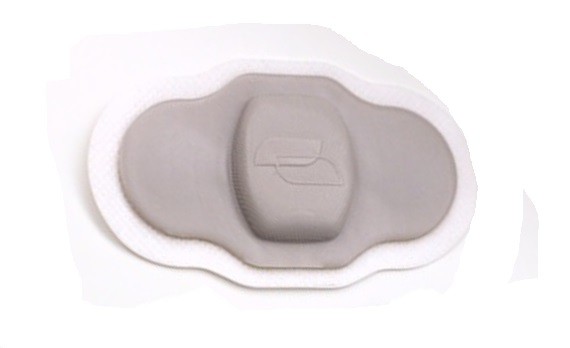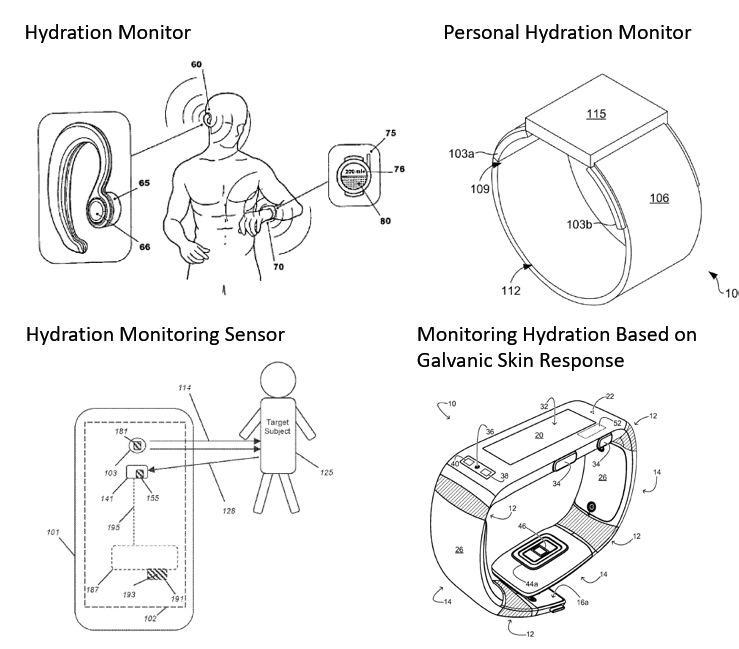1.Idea and Market
Total body water (TBW) can be determined by measuring deuterium and hydrogen from the skin of an individual. First, a certain amount of heavy form of water, deuterium oxide () is ingested. Then, the deuterium and hydrogen amount that is thrown out by sweating is measured by the solid state chemical sensor. The TBW is obtained from the change in deuterium and hydrogen compared to the amount that was taken in. Hydration of an individual is calculated from the ratio of TBW to fat-free mass (FFM) [3].
This product addresses professional athletes both sportswomen and sportsmen but in fact, it can be used by anyone who does a cardio sport. Chris Jones – England Athletics CEO – stated that there are 131,000 athletes who paid a registration fee to become a member of England Athletics, in 2014 [4]. The research findings of Sport England show that in the UK, the number of people who do a moderate intensity physical exercise at least 3 sessions a week has raised by 1,400,000 over the last 10 years and reached to 7,761,000 people between October 2015 and September 2016 [5].
The commercially available device that is used to measure TBW and body fat is called bioelectrical impedance analyser (BIA) which can often be found in gyms. However, this device is not wearable, costly, and the measurements alter depending on whether the subject is on an empty stomach or not, and also the amount of water intake. There are some researches have been undertaken in order to develop a wearable measurement device, some of these devices are patented and others are in the patents application process nevertheless none of these products are commercially available yet.
The dehydration sensing device that is presented in this document provides a low power real-time monitoring method. It is lightweight and wearable, and it displays the dehydration level on a smart watch where the data is transferred through low-energy wireless communication. The cost estimation to produce 100 and 1000 devices is given by Table 2-1. Note that, price of a smart watch is not included which can be purchased for £21-£51 [6].

Table 2‑1 Cost estimation to produce 100 and 1000 devices
As a comparison, blood pressure monitors can be purchased for £24.99-£32.34 [7]. Therefore, setting a price tag of £30 if 100 devices were produced and £25 if 1000 devices were produced appears to be reasonable.
2.Review and Current State-of-the-Art
There are two methods to measure TBW and hence the body hydration of an individual. These methods are dilution and equilibration, and BIA. The first method, dilution and equilibration, is a chemical sensing method. This method was used in the proposed dehydration sensing device since the results obtained by the second method, BIA, are not accurate. BIA method relies on the flow of an electric current through body skin which makes this method inaccurate since the skin impedance is subject to change, e.g. loss of water increases electrical resistance of the body [8].
There are a number of patents and patent applications that already exist in the field of measuring dehydration by a wearable device. The visuals of these products are provided in Appendix.
1.1.Hydration Monitor (US Patent 8754165) [9]
This device measures the subject’s core body temperature by a temperature sensor then a processor calculates the hydration level depending on the changes in core body temperature.
1.2.Personal Hydration Monitor (US Patent Application 20160338639) [10]
North Carolina State University developed a device to measure the skin impedance by attaching a flexible electrode which is an Ag Nanowire sensor. Then, the processing circuitry calculates the hydration level of the subject. This sensor can be attached on the wrist or as a chest patch.
1.3.Hydration Monitoring Sensor (US Patent Application 20150148623) [11]
This device uses a BioAware sensor which consists of white LEDs and an array of photodiode which emits the reflected light from the skin of a subject, to monitor the hydration level. The results are then transmitted to a cell phone or a smart watch.
1.4.Monitoring Hydration Based on Galvanic Skin Response (US Patent Application 20160374588) [12]
This device is a watch that has a built-in sensor to measure galvanic skin response over time which is an indication of how hydrated the body is and the results are displayed on the screen of the watch. The sampling frequency can be adjusted depending on whether a user activity is detected or not.
1.5.Proposed Method of Measuring Dehydration

Figure 3.1 Block diagram of the chemical sensor, top view and side view, adapted from [13]

| Figure 3.2 [13] Detected chemicurrent from deuterium and hydrogen atoms as a function of time |
3.Preferred Design and its Implementation
Since the proposed device needs to operate for long periods of time, the energy consumption of the device is minimised by using an ultra-low-power microcontroller and a Bluetooth low energy (BLE) module. Figure 7.1 and Figure 7.2 (in Appendix) shows the current consumption of BLE module and MSP430 microcontroller as a function of time, respectively. A push-button is mounted to pair the BLE with a smart watch which displays the transmitted data. The system is powered by a 225 mAh Lithium Battery. To demonstrate, this battery would supply enough energy to run the selected BLE module for 390 days. The calculation is given in Appendix 7.1. Figure 4.1 is provided as an example to show what the proposed device will look like. It can be seen that the size is small enough to be carried by an athlete during an activity.

Figure 4.1 An example device, adapted from [15]

Figure 4.2 shows the system block diagram.
The sensor measures the change in deuterium and hydrogen in sweat, then this signal is amplified and converted to digital. LED flashes to indicate that measurement is taken. The digital signal is transmitted to a smart watch where the mobile app processes the data and the result is displayed. Since the dehydration level does not alter rapidly, the device makes a measurement in 60 second intervals by default, which can be changed by the user as desired. Between each measurement, the device goes into a low power mode to save power while a timer starts counting to wake the device up before a measurement. Figure 7.3 (in Appendix) is an example visual of the final product which is expected to weigh approximately 15 grams.
4.Prototype Delivery
Prototype manufacturing procedure includes ordering the components, electronic circuitry and PCB design, mechanical design, assembly, programming and testing of the device. Making a rough estimate, these intermediate steps would be completed in a month. Due to economy of scale, the cost of manufacturing a single device would be higher than producing in large quantities. Table 2-1 shows that the cost of purchasing a single unit of the needed materials is around £1,600 including a smart watch for testing and the cost of labour during the estimated time frame of production.5.Conclusion and Recommendations
Making the assumption that a prototype and 1000 devices are produced, an initial investment of £16,000.00 is required (calculation is provided in Appendix 7.1). Assuming that the production has followed the anticipated time schedule, 14 weeks would be needed. Also if each product is sold by the end of 12 months with the projected price tag of £25, the total profit would be £9,000.00 excluding the cost of shipping of devices.
It should be taken into account that the cost of purchasing the sensors may increase due to demand oriented pricing, in that case the sensor may be manufactured instead of purchasing off the shelf. Making the assumption that it would cost 3 times as much to manufacture the same sensor, the cost per device would raise from £14.42 to £17.22 if 1000 devices were produced. As a result, the total profit at the end of the year is reduced from £9,000.00 to £6,176.10. (The calculations are provided in Appendix 7.1)6.Appendix

Figure 7.1 Power consumption of the Bluetooth Module, adapted from [16]

Figure 7.2 Power consumption of the MSP430 microcontroller at Active mode and different Low-Power Modes, taken from [17]

Figure 7.3 Example visual of the final product, taken from [18]

Figure 7.4 Visuals of existing products. Adapted from [9] [10] [11] [12]
6.1.Calculations
Calculation of number of days:
Average current draw of BLE is 0.024mA.
2203 Coin Battery supplies 225 mA per hour.
Number of hours: which corresponds to 390 days.
Calculation of required initial investment:
Cost of manufacturing a prototype and purchasing a smart watch (for testing): £1,600.00
Cost of manufacturing 1000 devices: 14,416.00
Total cost of manu(approximately): £16,000.00
Calculation of total profit if each device costs £14.42:
Total income: £25 x 1,000 = £25,000.00
Total profit: £25,000.00 - £16,000.00 = £9,000.00
Calculation of total profit if each device costs £17.22:
Total cost: £17,223.90 + £1,600.00 = £18,823.90
Total profit: £25,000.00 - £18,823.90 = £6,176.10
References
| [1] | A. Adan, “Research Gate - Cognitive Performance and Dehydration,” 01 04 2012. [Online]. Available: https://goo.gl/dRWdLm. [Accessed 26 04 2017]. |
| [2] | A. Jeukendrup and M. Gleeson, “Dehydration and its Effects on Performance,” in Sport Nutrition: An Introduction to Energy Production and Performance, Birmingham, 2012, p. 488. |
| [3] | Z. S. B. W. Flavia Meyer, Fluid Balance, Hydration, and Athletic Performance, CRC Press, 2016. |
| [4] | C. Jones, Interviewee, Chris Jones End of Year Message. [Interview]. 22 December 2014. |
| [5] | “Sport England - Active People Survey,” 01 December 2016. [Online]. Available: https://www.sportengland.org/research/about-our-research/active-people-survey/. [Accessed 26 April 2017]. |
| [6] | “Bluetooth Health Smartwatch,” Light in the Box, [Online]. Available: https://goo.gl/dUScPD. [Accessed 26 04 2017]. |
| [7] | “Amazon - Blood Presure Monitors,” [Online]. Available: https://goo.gl/td11fX. [Accessed 26 04 2017]. |
| [8] | H. C. Lukaski, W. W. Bolonchuk, C. B. Hall and W. A. Siders, “American Physiological Society - Validation of Tetrapolar Bioelectrical Impedance Method,” April 1986. [Online]. Available: http://jap.physiology.org/content/jap/60/4/1327.full.pdf. [Accessed 26 April 2017]. |
| [9] | L. T. L. Marsh, “Hydration Monitor”. United States Patent 8574165, 05 11 2013. |
| [10] | Myers, Amanda, Malhotra, Abhishek, Muth, John, Zhu, Yong and Yao, Shanshan, “Personal Hydration Monitor”. United States Patent 20160338639, 24 11 2016. |
| [11] | D. A. Benaron, “Hydration Monitoring Sensor and Method for Cell Phones, Smart Watches, Occupancy Sensors, and Wearables”. United States Patent 20150148623, 28 05 2015. |
| [12] | Shariff, Farah, Hingorani, Vinod L. and Albadawi, Haithem, “ MONITORING HYDRATION BASED ON GALVANIC SKIN RESPONSE”. United States Patent 20160374588, 29 12 2016. |
| [13] | Mcfarland, Eric W., Weinberg, Henry W., Nienhaus, Hermann, Bergh, Howard S., Gergen, Brian and Mujumdar, Arunava, “Free Patents Online”. United States Patent 7057213, 06 06 2006. |
| [14] | “Universität Duisburg-Essen - Chemicurrents,” 25 August 2014. [Online]. Available: https://www.uni-due.de/ag-nienhaus/research---chemicurrent.shtml. [Accessed 26 04 2017]. |
| [15] | G. Ellwood, “Wearable sensor MetaWear,” Entertainment Focus, 24 06 2015. [Online]. Available: https://goo.gl/1YqMjd. [Accessed 26 04 2017]. |
| [16] | S. Kamath and J. Lindh, “Texas Instruments - Measuring BLE Power Consumption,” 2012. [Online]. Available: http://www.ti.com/lit/an/swra347a/swra347a.pdf. [Accessed 26 04 2017]. |
| [17] | “Texas Instruments - Overview for MSP430G2x/i2x,” 01 07 2013. [Online]. Available: http://www.ti.com/lit/ug/slau144j/slau144j.pdf. [Accessed 26 04 2017]. |
| [18] | A. Kelly, “Proteus Discover,” Qualified Suppliers to Medical Devices Industry (QMED), 24 04 2014. [Online]. Available: https://goo.gl/QVjR5r. [Accessed 26 04 2017]. |